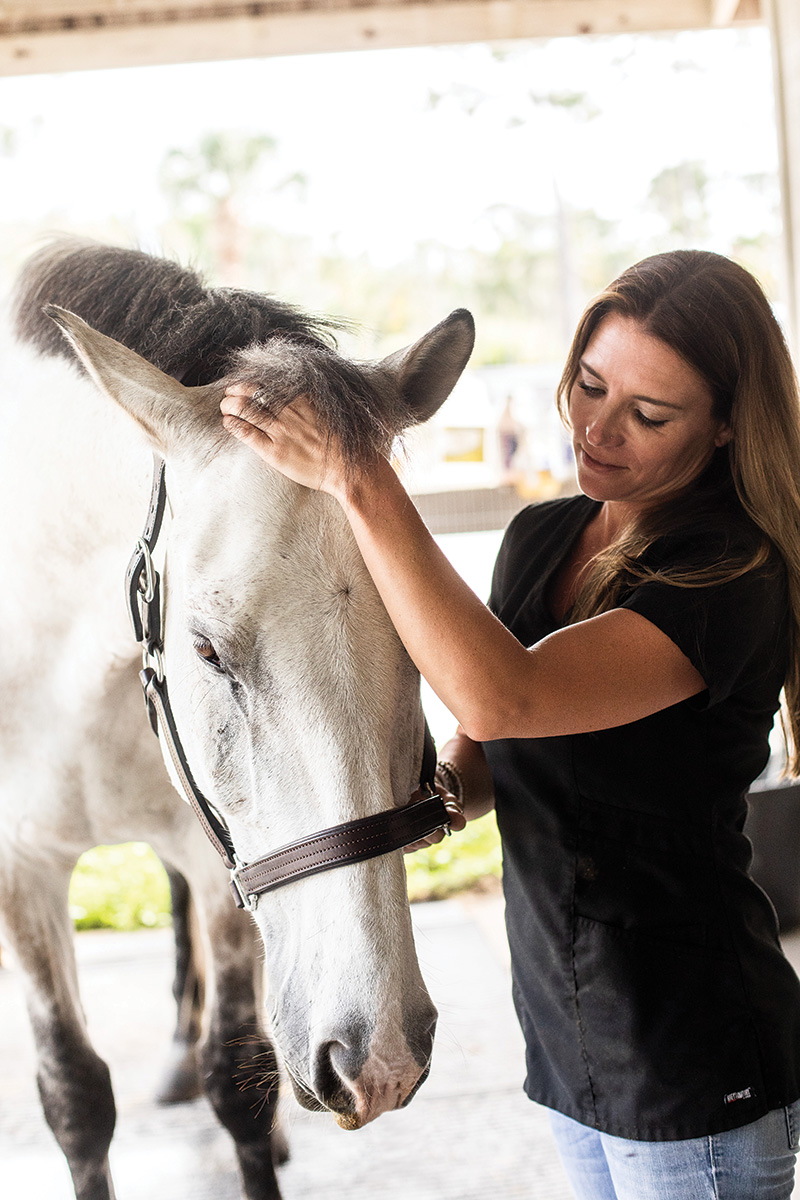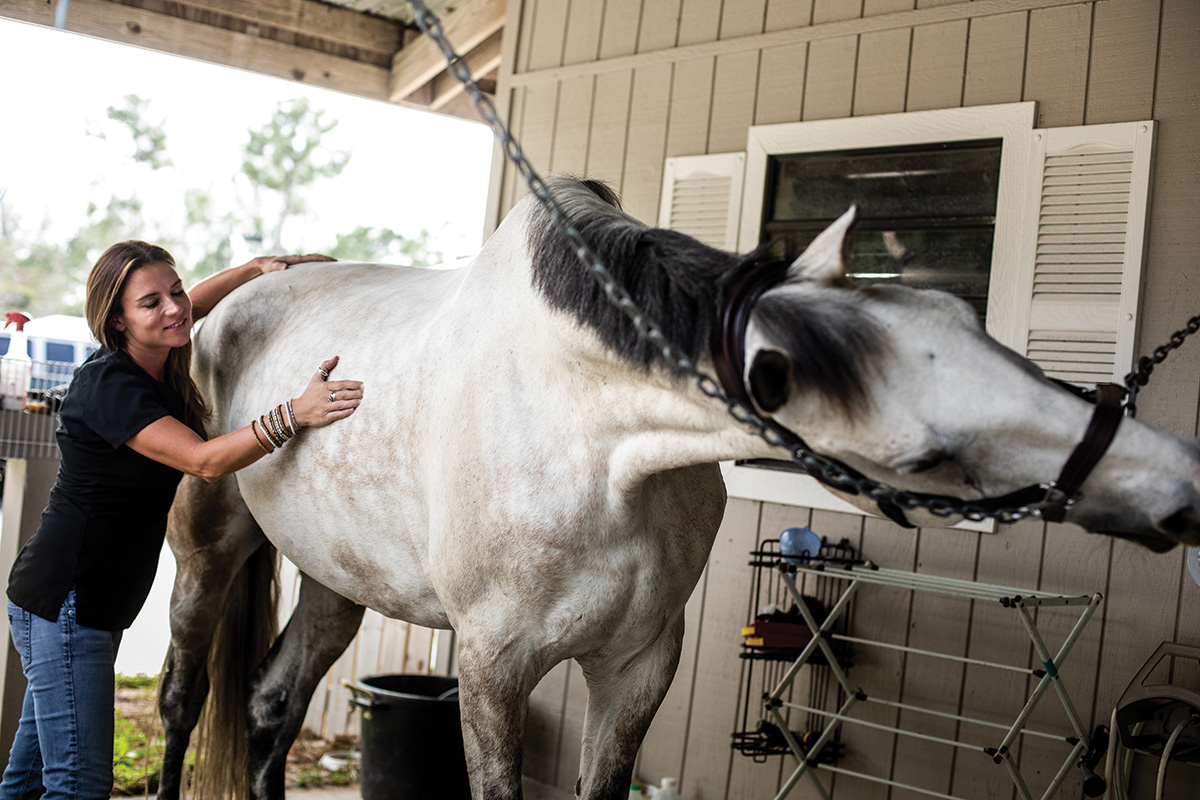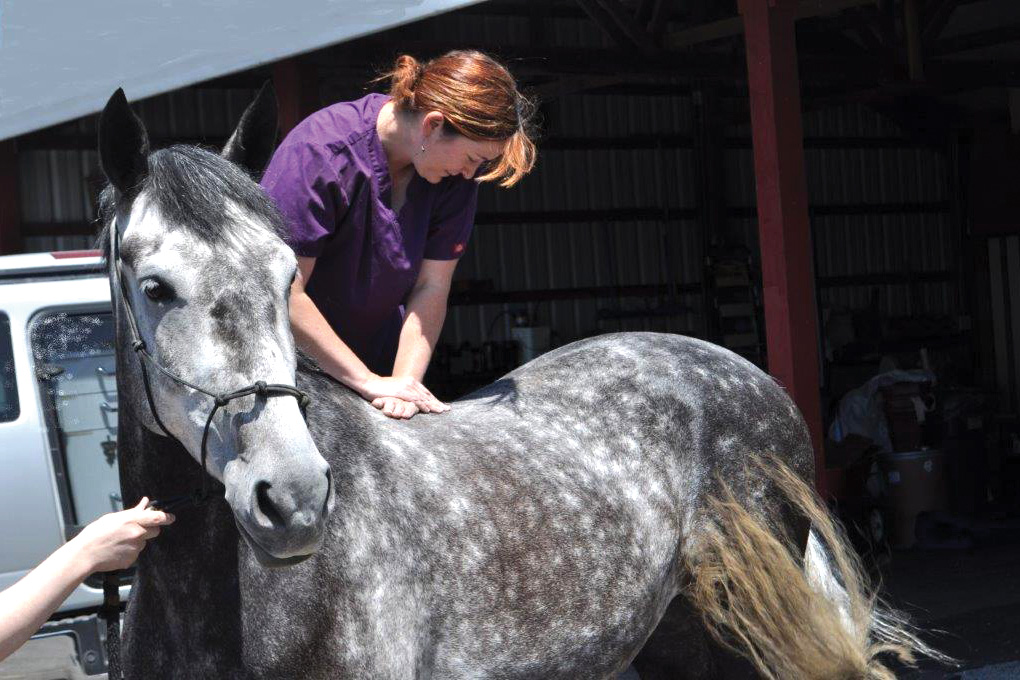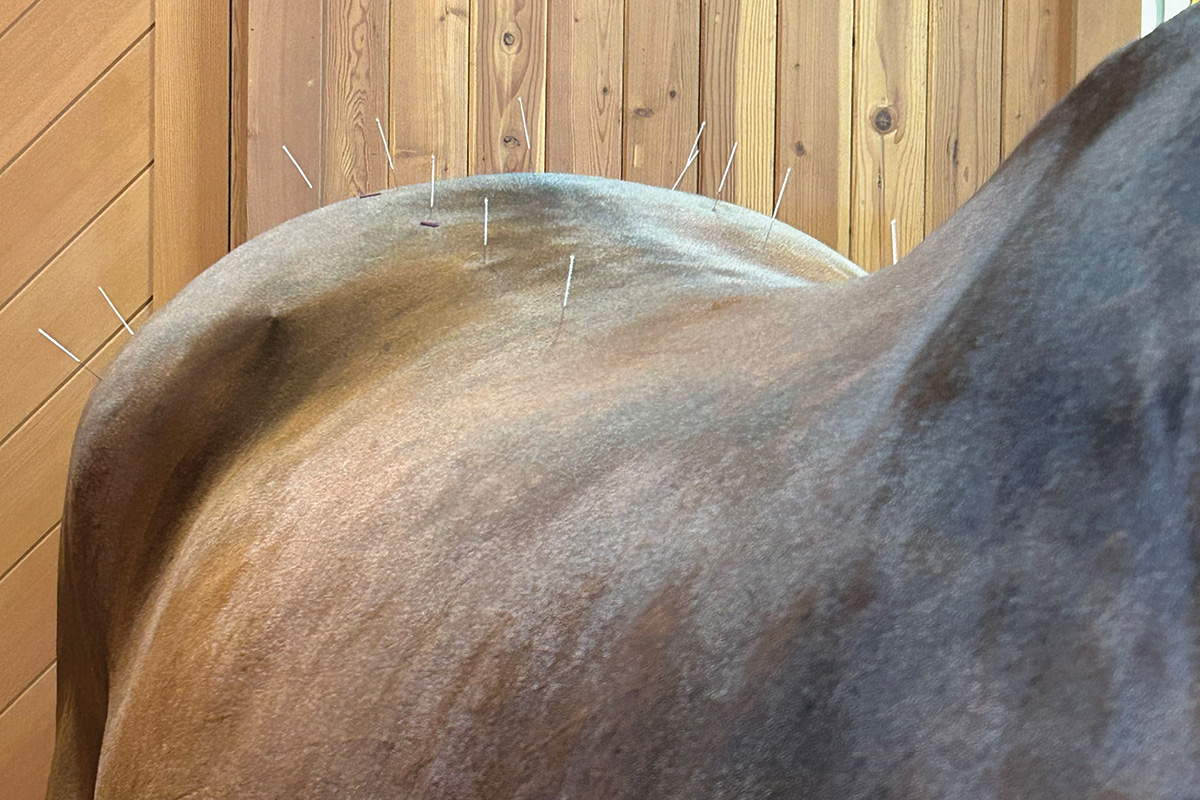These days, we have many options when it comes to treating our horses if they are in pain. Of course, it’s always good to see your vet and get a full evaluation, but many horse owners have found that including alternative therapies can really make a difference in your horse’s care. Learn about five of the most popular therapies and when they may benefit your horse.
Bodywork
Massage may be considered part of bodywork, but not all bodywork is massage.
“Bodywork is more of a broad term incorporating a lot of different modalities, like stretching, acupressure, myofascial release, manipulative therapy, breath work, or energy medicine,” explains Meghan Brady, a certified Masterson Method practitioner for equine bodywork, among many other therapies, based in Virginia.

“Bodywork techniques also aim to assess or improve posture, promote awareness of the body-mind connection (an approach that sees the body and mind as a single integrated unit), or to manipulate the electromagnetic field alleged to surround the body and affect health,” says Brady.
Because of the wide range of techniques, the list of benefits is lengthy. These include relaxation and stress reduction, improved posture, activating under-used muscles and deactivating over-used muscles, increasing joint flexibility and range of motion, encouraging faster healing, improving blood and lymph fluid circulation, strengthening the immune system, and more.

Sara Hassler, a client of Brady’s, has seen a vast improvement in her barn full of horses.
“Meghan has worked on my horses for the past few years and has made a tremendous difference both in their training as well as day-to-day demeanor,” she says. “The horses have an overall sense of peace and relaxation as she works on them, and their minds and bodies feel ready for action! They consistently feel softer and more elastic through their bodies after a session, and the feeling lasts a long time.”
Brady adds that bodyworkers don’t treat injuries or ailments, and all horses should see a vet before being started on bodywork.
Massage
Most of us are familiar with massage therapy. A therapist uses different pressures to manipulate muscles, tendons and ligaments. It’s known to help relieve stress, tension, tightness and soreness.
Leda Mox, a certified equine sports massage therapist and owner of Armstrong Equine Massage LLC in Minnesota has been using massage on horses for over 25 years with great results as a treatment, but also as a preventative.
“There are many reasons why your horse would need a massage,” she says. “The first and most important reason is to prevent injuries.” She adds that massage also helps increase blood flow, boost the immune system, increase range of motion, improve flexibility, and assist with pain management.

Mikayla Tibbetts, a client of Mox, found massage a blessing for her horse Moseby, an off-track Thoroughbred.
“He came to me lacking muscle, strength and balance, and was sore in multiple areas,” she says. “Since his massages, he has become so much happier in his work. As he’s developed muscle, Leda has helped identify his sore spots and given me new stretches to target those areas. After his massage, he picks up his canter leads so much easier.”
Chiropractic
Chiropractic adjustment—the manipulation of bones and joints—has become almost mainstream as a human treatment, and is rapidly gaining popularity with horses as well.
Anne Marie Ray, DVM, is a veterinarian at Ridgefield Equine Clinic in Washington state who also practices chiropractic care.
“In simple terms, chiropractic care is to adjust the chiropractic subluxations affecting the nervous system to allow the body to heal itself,” she explains. “I like to think of it as a tool in our toolbox for treatment for a variety of issues. It may be used complementary to other treatment options to ensure the best care for our patients.”

Her favorite patient story happened while she was in chiropractic school during a hands-on lab class where the students, including her, were supposed to be palpating the cervical vertebrae on a horse’s spine.
“It was cold and windy that day, and the horse we were trying to work on appeared anxious, uncomfortable, and did not want to stand to allow us to palpate him,” she says. “Our professor asked the owner if she could adjust the horse, and after adjusting the horse’s neck, he took a deep breath and stood perfectly for the rest of the afternoon. I’ll never forget that moment, because it showed me that chiropractic care has a place in veterinary medicine, and that we need to keep an open mind about modalities that will keep our patients healthy.”
Ray says that while most horse owners come to her after an injury or an issue such as lameness, back pain, or a change in behavior, she says it works best as way of decreasing the chance of these problems occurring.
Acupuncture
Acupuncture is an ancient Chinese therapy that uses thin metallic needles inserted into the skin at very precise locations. These are then moved gently and specifically to stimulate tissue, muscles and nerves.
Linda Cimetti, DVM, is a veterinarian at South Shore Equine Clinic & Diagnostic Center in Massachusetts who is also certified in equine acupuncture. She says most of her acupuncture patients are suffering from musculoskeletal injuries, although she also helps horses that have routine pains from training and showing.
“I see a lot of clinically sound horses get that last 10 to 15 percent of performance that you can’t achieve without alternative medicine,” says Cimetti. “A lot of horses in training have sub-clinical neck, back, or hip pain, as well as joint pain that can be identified and addressed with regular acupuncture treatments—before it develops into a clinical unsoundness.”

Cimetti helped the owners of Equinox Bossanova, a Morgan stallion, find the cause of his lameness using acupuncture when no other vets had been successful. She found his stifle acupoints to be very reactive.
After the treatment he was better, but not 100 percent sound, so Cimetti combined acupuncture with stifle joint injections.
“We got the horse’s stifles injected and he was fixed,” says his owner, Christine Nava- Moulthrop of Timber Hill Stables in Kingston, Mass. “It took Linda’s non-traditional methods to find the problem. If it wasn’t for her, I’d still be trying to figure out what was wrong.”
Boss went on to a successful show career and was inducted into the American Morgan Show Horse Hall of Fame in 2018 and the Connecticut Morgan Show Horse Hall of Fame in 2023.
If you’re interested in alternative therapies for your horse, it’s always good to start by discussing it with your vet to see which type they think might work best for your particular situation.
PEMF
PEMF stands for pulsed electromagnetic field. Each of the cells in your horse’s body has an electric charge; when the charge gets low, the cells cannot heal and are dysfunctional. PEMF technology uses a pulsing electromagnetic charge to stimulate cells and essentially recharge them, allowing for tissue healing and reducing inflammation and pain.
Amy Perez, owner/trainer of Stellar Equine Solutions LLC in Washington state, is certified in PEMF therapy and helps people, horses and small animals with PEMF treatments.
“I firmly believe there is not one injury or ailment that doesn’t benefit from PEMF,” she says. “From sore muscles to broken bones, arthritis, Cushing’s, navicular, or just daily maintenance for our hard-working horses, PEMF can help it all.”
She has seen many horses have incredible reactions to treatments.
“I have treated a horse with a broken leg through a cast, [which] helped speed up the healing process and the horse fully recovered. I have treated horses that could barely walk due to a Cushing’s flare-up, and by the end of the session, they trotted off in their pasture. Every horse starts to get a soft eye, begins yawning, and lets out a huge sigh of relaxation during treatment. Most of their owners’ reactions start with a ‘wow’ and end with ‘I am so glad to see my horse happy again.’
“The main benefit for PEMF with horses would be pain relief,” Perez continues. “PEMF oxygenates the blood cells to promote healing in the body. The body naturally heals itself, but sometimes it can’t get back to complete repair without help. PEMF does just that—it helps the body heal itself.”
Summer Crosby has seen incredible results.
“My horse, Shooter, receives PEMF therapy on a regular schedule from Amy Perez,” she says. “Shooter has had ongoing issues in his right shoulder for some time: soreness, short striding and frequent lameness. After a year of vet visits and no real diagnosis, it was suggested to start Shooter on PEMF therapy. The changes I’ve seen following his treatments have been nothing short of amazing. Shooter has received both chiropractic and massage therapy, and the PEMF has helped him achieve even greater progress. We have been able to continue competing on a regular basis.”
Expert Resources◆ Amy Perez: facebook.com/stellarequinesolutions ◆ Anne Marie Ray, DVM: ridgefieldequine.com ◆ Leda Mox: armstrongequinemassage.com ◆ Meghan Brady: meghanbrady.us ◆ Linda Cimetti, DVM: ssequineclinic.com |
Key Takeaway
Therapies outside the standard western medical options are continuing to gain steam as horse owners discover their complementary benefits to equine health and soundness. You may find that trying out these alternative therapies in your horse’s care routine may do wonders for his health.





